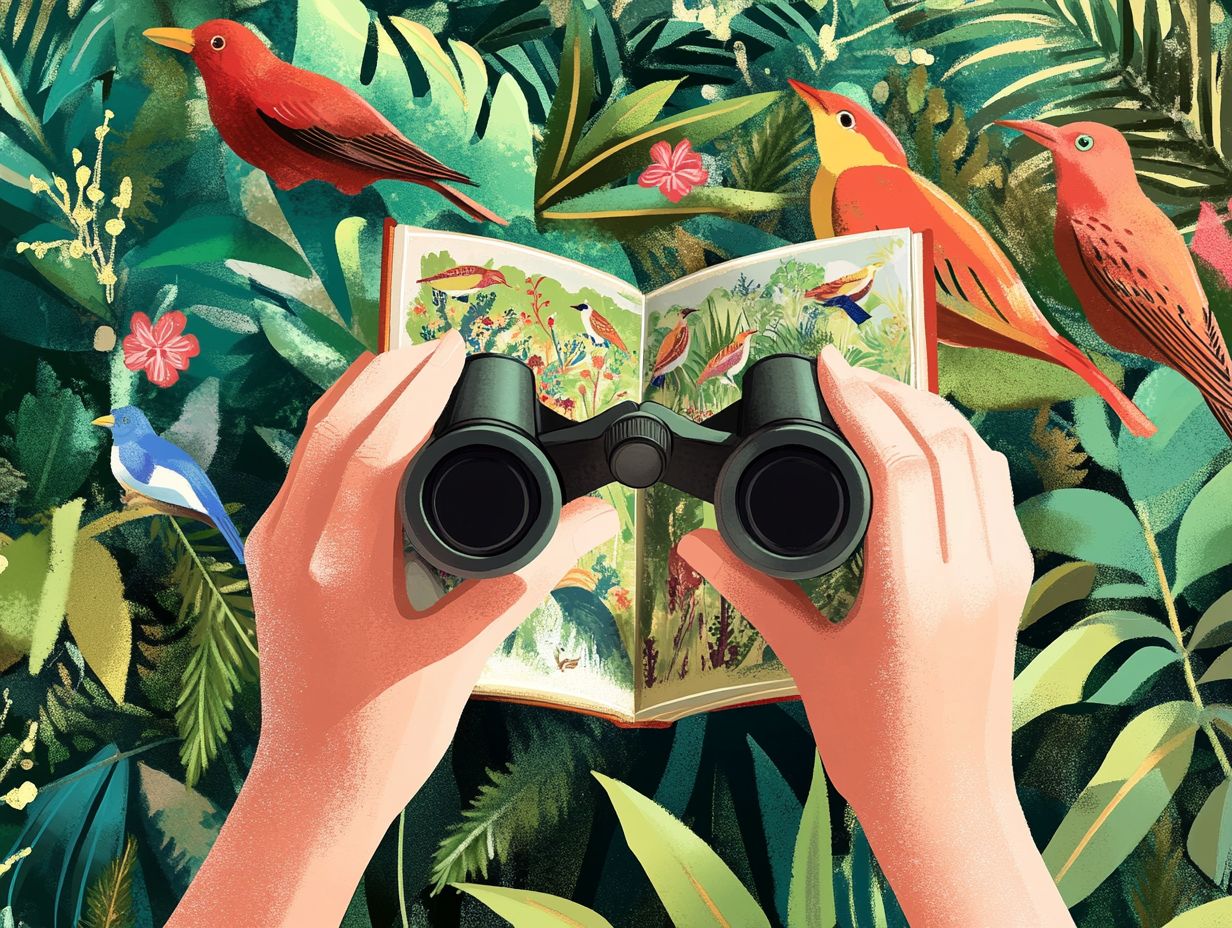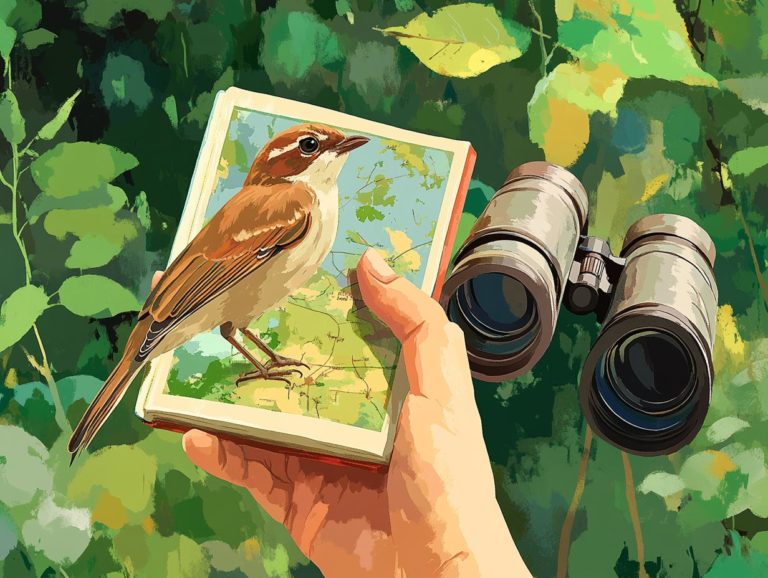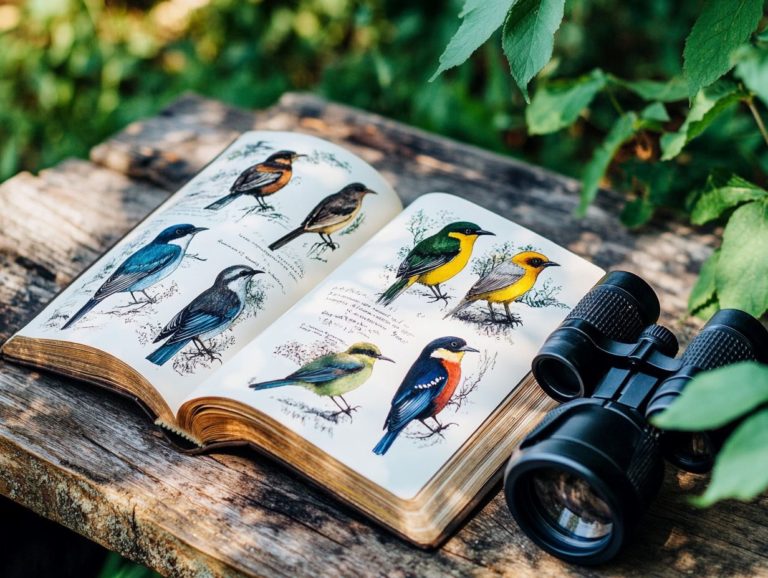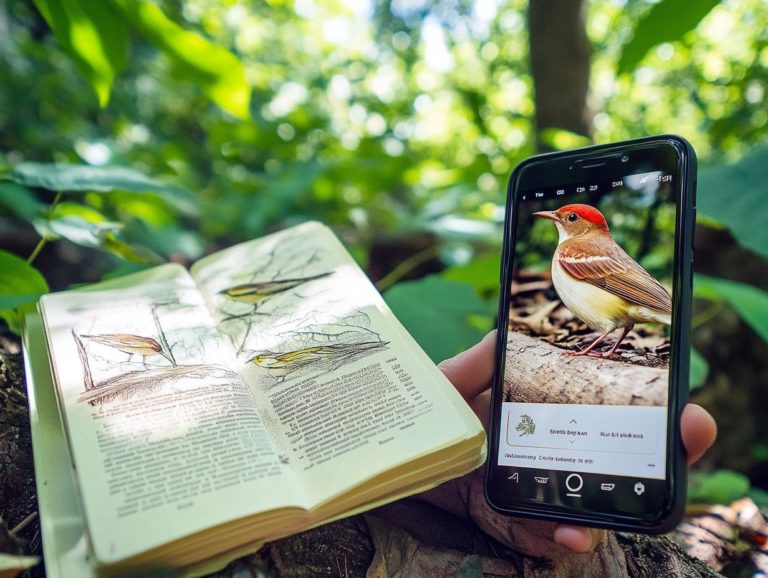Field Guides: A Pathway to Birding Mastery
Field guides are indispensable tools for anyone passionate about birds, especially in regions rich in avian diversity like Bolivia. They serve as a bridge between your initial curiosity and a deeper expertise.
These resources not only aid in identifying various species found in locations like Trinidad and Tobago but also enrich your understanding of bird behavior and their habitats. Whether you’re just starting out or have years of experience in birding tours, choosing the right guide can significantly enhance your field experience.
This article delves into the numerous benefits of utilizing field guides focused on the 1,435 species of Bolivia, provides practical tips for their effective use, and discusses how to craft a personalized guide tailored to your birding adventures.
Dive in and discover the amazing world of birds! Your birdwatching skills will soar to new heights, from observing Hummingbirds to Raptors migration.
Contents
Key Takeaways:

- Field guides are essential tools for birders, providing valuable information on bird identification, distribution, and habitat.
- Using field guides can greatly improve bird identification skills and expand knowledge of bird behavior and habitat, especially in regions with a variety of wildlife like the Pantanal wetlands.
- When choosing a field guide, consider factors such as size, illustrations, color plates, and range maps, and utilize advanced techniques to enhance your birding experience.
What are Field Guides?
Field guides are invaluable resources for both amateur and professional birders, offering in-depth information on bird identification and distribution. For those looking to enhance their skills, exploring field guides: building your birdwatching knowledge can be especially beneficial, particularly in biodiverse regions such as Bolivia and the Pantanal.
These guides describe 1,435 species in Bolivia, including rare ones like the Hyacinth Macaw, catering to the needs of bird scientists, birding tour leaders, and conservation biologists alike.
By utilizing these guides, you can elevate your birding experience, effortlessly identifying unique species such as the Scarlet Ibis and gaining a deeper understanding of their habitats.
Definition and Purpose
A Field Guide serves as your go-to reference, whether in print or digital form, helping you identify and understand the myriad bird species found in locations like Trinidad and Tobago, their behaviors, and their habitats.
These guides help you connect more deeply with nature, an essential component for effective bird identification and conservation efforts to protect local biodiversity. As you embark on birding tours through biodiverse areas like the Pantanal wetlands, the detailed illustrations and comprehensive descriptions will enhance your experience, allowing you to truly appreciate the unique characteristics of each bird, including notable species like the Orange-breasted Falcon.
Natural resource managers rely on these tools to monitor avian populations, especially in regions like Bolivia, develop conservation strategies, and educate the public about the importance of the variety of wildlife. Ultimately, Field Guides play a pivotal role in bridging the gap between you and the natural world, encouraging a profound appreciation for avian life and the ecosystems that sustain it, including important habitats for species like the Ruby-topaz Hummingbird.
Benefits of Using Field Guides
Employing field guides presents a wealth of advantages for birders, researchers, and conservation biologists alike, particularly when exploring areas of rich avian diversity. These resources significantly enrich your understanding of avian diversity and behavior, particularly in areas renowned for their rich birdlife, such as Bolivia, the Pantanal wetlands, and Australia.
Improving Identification Skills
Field guides significantly enhance your bird identification skills by providing detailed descriptions, visual aids, and comprehensive information on the 1,435 species found in regions like Bolivia. This includes many unique birds such as the Great Blue Heron. They are essential for a successful birding tour, especially when targeting specific events like raptor migration, which refers to the seasonal movement of birds of prey.
These resources equip you with essential cues, such as size, plumage color, and distinctive markings. This allows for quicker and more accurate identifications of species, including the American Flamingo. The inclusion of habitat preferences and behavioral notes enriches your experience, enabling you to anticipate bird movements and behaviors with greater ease, particularly during migration seasons.
When you embark on birding tours, having these amazing tools at your fingertips fosters a deeper connection with avian wildlife. Imagine spotting the Trinidad Piping-Guan and elevating your overall adventure! By relying on these guides, whether you’re a novice or a seasoned birder, you can effectively enrich your outings in places like Trinidad and Tobago. This ensures that every sighting transforms into a memorable moment in nature.
Learning About Bird Behavior and Habitat

Understanding bird behavior and habitat is essential for you, whether you’re a passionate bird enthusiast or a dedicated conservation biologist working to protect vulnerable species. Field guides become your trusted allies, offering invaluable insights and data that illuminate these vital aspects.
These resources highlight the identifying features of various species and explore their feeding habits, nesting practices, and migration patterns, particularly during raptor migration. By presenting this information in an accessible format, field guides empower you to observe and truly appreciate the rich tapestry of avian life surrounding you, including the captivating Hummingbirds.
As you engage with these guides, you transform into a more informed advocate for conservation efforts. You will recognize the critical importance of preserving natural habitats that support diverse bird populations. This heightened awareness can inspire community initiatives and bolster support for policy changes designed to protect essential ecosystems, like those found in Bolivia. These efforts ultimately benefit both local wildlife and the environment as a whole.
Choosing the Right Field Guide
Choosing the right field guide is crucial for effective bird identification and comprehension, particularly in areas renowned for their avian richness. This is especially important for bird experts and conservation biologists who depend on precise information to underpin their research and initiatives, particularly in biodiverse regions. Resources like field guides for bird conservation can be invaluable, especially in regions such as the Pantanal wetlands.
Factors to Consider
When selecting a field guide, consider several key factors: geographic focus, such as Bolivia birding, user-friendliness, and the depth of bird identification aids. These elements are crucial for both bird experts and avid birding enthusiasts.
Opting for a guide that s tailored to your specific region, like one focused on Trinidad and Tobago, significantly increases your chances of accurately identifying local species. This is true whether you’re navigating a lush forest or strolling along a serene coastline.
User-friendliness can truly enhance your birdwatching experience. Choose guides that feature clear illustrations, intuitive layouts, and relevant information about various bird species. This enriches your learning journey.
Choose guides that include detailed descriptions of songs, behaviors, and habitat preferences. These aids are vital for effective identification, especially during migration periods. They can deepen your understanding of avian life and foster a greater appreciation for the wonders of the natural world, such as the delicate balance of ecosystems where species thrive.
How to Use a Field Guide
Utilizing a field guide effectively requires employing a range of techniques for bird identification that significantly enriches your birding experience, particularly when observing raptor migration. Mastering these methods can elevate your outings, resulting in more successful birding tours and observations of unique species.
Step-by-Step Guide to Identification
A step-by-step guide to bird identification using field guides: your birdwatching companion can significantly elevate your experience during birding tours in places like Bolivia and refine your overall skills.
Familiarize yourself with sections like color plates and habitats to streamline your observations. Start by selecting a field guide tailored to your region, one that includes information on tropical birding and your experience level; this foundational step is essential.
Once you re out in the field, take a moment to attentively observe your surroundings. Pay close attention to the environment and sounds, especially those of unique species like the Yellow-crowned Night Heron, which can help you accurately identify bird species.
Using apps or websites that complement your field guide can enhance your experience. These tools provide detailed information and instant access to your discoveries, enriching your birding adventures even further.
Advanced Techniques for Field Guide Users

By employing advanced techniques, you can greatly enhance identification accuracy for field guide users, particularly during the raptor migration periods in tropical areas such as Bolivia and Trinidad and Tobago. This technique sharpens your skills and reveals fascinating bird behaviors, like those of the Scarlet Ibis, enriching your understanding of these magnificent birds.
Tips for Experienced Birders
Experienced birders can elevate their skills with targeted tips to enhance their use of field guides: bridging knowledge gaps in birding, especially during notable events like raptor migration in areas with rich bird populations.
By refining your observational skills and embracing a more strategic approach, such as focusing on the specific needs of conservation biologists, you can significantly improve your identification accuracy. Exploring a variety of field guides tailored to your region s species, including those that detail the behavior patterns, plumage variations, and vocalizations of species like the Orange-breasted Falcon, will grant you deeper insights.
Engaging with community resources, such as birdwatching forums or local conservation groups, will keep you well-informed about migration timelines and environmental conditions. Additionally, employing techniques like using binoculars for distant observations or positioning yourself in optimal viewing locations can remarkably increase your chances of spotting elusive migratory birds, such as the Great Blue Heron.
Creating Your Own Field Guide
Crafting your own field guide transforms your birding experience into something truly personal. It allows you to meticulously document your discoveries, including rare species encountered in regions like Bolivia. This personalization deepens your connection with areas teeming with avian diversity, like the captivating landscapes of Bolivia and the vibrant wildlife of the Pantanal.
Start your birding adventure today and discover the wonders of nature!
Personalizing Your Birding Experience
Personalizing your birding experience with a custom field guide enhances your bird identification skills. It also deepens your understanding of efforts to protect birds.
By adding personal notes, sketches, and photographs, you create a unique resource that captures your journey in the field. Tailoring the guide to specific habitats helps you recognize local species and connect to the surrounding ecosystem.
This customization allows you to include conservation tips from organizations dedicated to protecting bird populations. This personalized approach sharpens your skills and ignites your passion for conservation!
Frequently Asked Questions
What are field guides and how can they help me become a better birder?

Field guides are resources that provide information and illustrations of various bird species. They are essential for every birdwatcher as they help you identify birds by offering key features, behaviors, and maps.
Do I need to use field guides to become a birding expert?
No, while not necessary, field guides greatly enhance your birding experience and knowledge of different species.
What are some popular field guides that I can use?
Some popular field guides include “The Sibley Guide to Birds” by David Allen Sibley, “National Geographic Field Guide to the Birds of North America” by Jon L. Dunn and Jonathan Alderfer, and “Peterson Field Guide to Birds of North America” by Roger Tory Peterson.
Can I use digital field guides instead of physical ones?
Yes, digital field guides can be just as effective as physical ones. They often have additional features such as recordings of bird songs and calls, making them more portable and convenient in the field.
How can I use field guides to improve my birding skills?
Field guides can help you improve your birding skills by teaching you how to identify birds based on their physical features, behaviors, and habitats. Additionally, enhancing your birdwatching experience with these resources can aid in tracking your sightings and maintaining a birding journal.
Are there any downsides to using field guides?
One potential downside to using field guides is that they may not always be 100% accurate, as bird species can vary in appearance and behavior. It’s important to use multiple sources and cross-reference information when using field guides to ensure accuracy.
Start personalizing your own field guide today!






